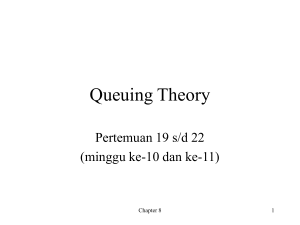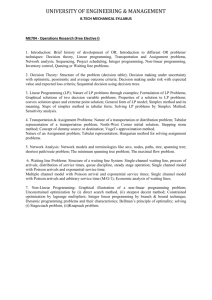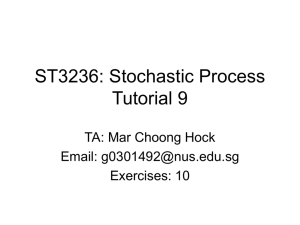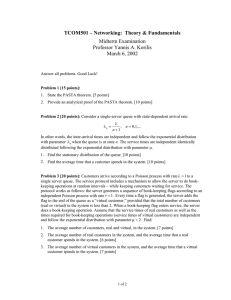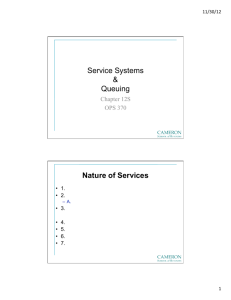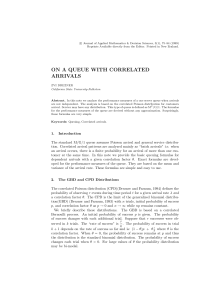Queuing Theory
advertisement
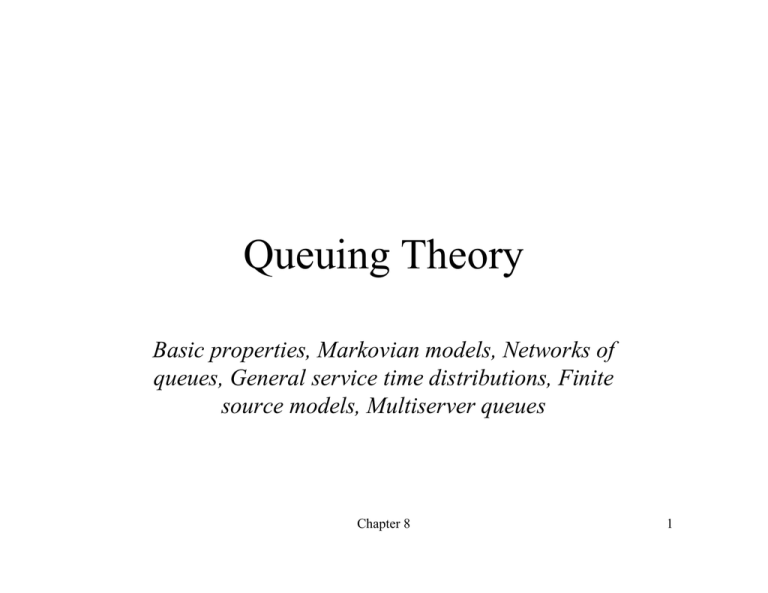
Queuing Theory
Basic properties, Markovian models, Networks of
queues, General service time distributions, Finite
source models, Multiserver queues
Chapter 8
1
Kendall’s Notation for Queuing Systems
A/B/X/Y/Z:
A = interarrival time distribution
B = service time distribution
G = general (i.e., not specified); M = Markovian
(exponential); D = deterministic
X = number of parallel service channels
Y = limit on system pop. (in queue + in service); default is ∞
Z = queue discipline; default is FCFS (first come first served)
Others are LCFS, random, priority
Chapter 8
2
Other Notation
Random variables:
X(t) = Number of customers in the system at time t
S = Service time of an arbitrary customer
W* = Amount of time an arbitrary customer spends in the system
WQ* = Amount of time an arbitrary customer spends waiting for service
Often we are most interested in the averages or expectations:
L = E X ( t )
LQ = Average number in the queue
LS = Average number in service
Chapter 8
W = E [W *]
WQ = E WQ *
3
Little’s Formula
wn * is the time spent in the system by the nth customer.
Assume these
k
system times are uniformly finite and let w = lim k →∞ k1 ∑ n =1 wn *
be the customer average time spent in the system.
s
1
Also, let X = lim s →∞ s ∫ X (t )dt
0
be the time average number of jobs in the system.
Then under very general conditions, X = λa w
where λa is the arrival rate. This is usually written L = λaW.
The mean number of customers in the system is proportional
to the mean time in the system!
Chapter 8
4
Heuristic Proof of Little’s Formula
A(t)
B(t) = cum. area
between curves
D(t)
T
T
N
Two ways to compute B(T ) = ∑ n =1 wn * = ∫0 X (t )dt
Mean time in system in (0,T): W (T ) = B(T ) N = B (T ) A(T )
Mean number in system in (0,T): X (T ) = B(T ) T
X (T ) = lim
Then Tlim
T →∞
→∞
B (T ) A(T )
= lim λ (T ) W (T ), or L = λaW
T →∞
A(T ) T
Chapter 8
5
Other Little’s Formulae
In queue: LQ = λaWQ
In service: LS = λa E [ S ]
and their implications…
Expected number of busy servers LS = λa E [ S ] ≡ ρ
Expected number of idle servers
# servers − ρ
Single server utilization
LS = λa E [ S ] = ρ
Single server prob. of empty system
1− ρ
Chapter 8
6
Observation Times
Pn = limt →∞ P { X (t ) = n} , n = 0,1,...
an = Proportion of arriving customers that find n in the system
dn = Proportion of departing customers that leave behind n in the
system
If customers arrive one at a time and are served one at a time then
an = d n
But these proportions may not match the limiting probability
of having n in the system (long run proportion of time that n
are in the system)
However, if arrivals follow a Poisson process then an = Pn
This is known as PASTA (Poisson Arrivals See Time Averages)
Chapter 8
7
M/M/1 Model
Single server, Poisson arrivals (rate λ), exponential service
times (rate µ)
CTMC (birth-death) model:
Chapter 8
8
M/M/1 Steady-State Probabilities
Pn = limt →∞ P { X (t ) = n} , n = 0,1,...
Level-crossing equations:
λ Pn = µ Pn +1 , n = 0,1,…
Solve for Pn in terms of P0
Pn =
( )
λ
µ
Then use the facts that
and substitute ρ = λ / µ
to get
n
n
P0 , n = 1, 2,…
∑ n=0 Pn = 1,
∞
−1
n
r
=
(1
−
r
)
if r < 1
∑ n=0
∞
Pn = ρ (1 − ρ ), n = 0,1,… if ρ < 1
Chapter 8
9
M/M/1 Performance Measures
Steady-state expected number of customers in the system
L = ∑ n =0 nPn =
ρ
∞
Mean time in system
W=
L
λa
=
Mean time in queue
, if ρ < 1
1
1
=
by Little's Formula
µ (1 − ρ ) µ − λ
WQ = W −
Mean number in queue
1− ρ
1
µ
=
λ
µ ( µ -λ )
λ2
LQ = λWQ =
µ ( µ -λ )
Chapter 8
10
M/M/1 Performance Measures
Distribution of time in system (FCFS)
P[W * ≤ x] = ∑ n =0 an P[W * ≤ x | arrival sees n customers]
∞
= ∑ n =0 (1 − ρ ) ρ n P[W * ≤ x | W * ∼ gamma(n + 1, µ )]
∞
= ∑ n =0 (1 − ρ ) ρ n ∑ l = n +1 e − µ x ( µ x)l l ! = 1 − e − µ (1− ρ ) x , x ≥ 0
∞
∞
Exponential with parameter µ(1-ρ)
Reversibility: Departure process is Poisson with rate λ
Chapter 8
11
Finite Capacity: M/M/1/N Model
Single server, exponential service times (rate µ)
Poisson arrivals (rate λ) as long as there are ≤ N in the system
CTMC (birth-death) model:
Chapter 8
12
M/M/1/N Steady-State Probabilities
Pn = limt →∞ P { X (t ) = n} , n = 0,1,...
Level-crossing equations:
λ Pn = µ Pn +1 , n = 0,1,… , N − 1
Solve for Pn in terms of P0
Then use the facts that
N +1
1
−
r
∞
N
n
P
=
1,
r
∑ n=0 n
∑ n=0 = 1 − r (note: r need not be < 1)
( λ µ ) (1 − λ µ )
n
to get Pn =
1− (λ µ )
N +1
, n = 0,1,… , N
Chapter 8
13
M/M/1/N Performance Measures
(In the unlikely event that λ = µ, for n = 1,…, N, Pn = P0 = 1 ( N + 1))
Steady-state expected number of customers in the system, L,
has a “messy” closed form
L
Mean time in system W =
by Little's Formula
λa
but here, λa is the rate of arrival into the system λa = λ (1 − PN )
WQ = W −
1
µ
LQ = λ (1 − PN ) WQ
Chapter 8
14
Tandem Queue
λ
µ1
µ2
If arrivals to the first server follow a Poisson process and
service times are exponential, then arrivals to the second
server also follow a Poisson process and the two queues
behave as independent M/M/1 systems:
P{n customers at server 1 and m customers at server 2} =
λ
µ1
n
m
λ λ
λ
1
1
−
−
µ1 µ 2 µ 2
Chapter 8
15
Open Network of Queues
• k servers, customers arrive at server k from outside the
system according to a Poisson process with rate rk,
independent of the other servers
• Upon completing service at server i, customer goes to
server j with probability Pij, where ∑ j Pij ≤ 1
k
For j = 1,…, k, the total arrival rate to server j is λ j = rj + ∑ λi Pij
i =1
The number of customers at each server is independent nand
If λj < µj for all j, then P{n customers at server j} = λ j 1 − λ j
µj
µ j
that is, each acts like an independent M/M/1 queue!
Chapter 8
16
Closed Queuing Network
• m customers move among k servers
• Upon completing service at server i, customer goes to server j
with probability Pij, where ∑ j Pij = 1
• Let π be the stationary probabilities for the Markov chain
describing the sequence of servers visited by a customer:
k
π j = ∑ π i Pij ,
i =1
k
∑π
j =1
j
=1
Then the probability distribution of the nnumber at each server is
k π
k
j
Pm ( n1 , n2 ,..., nk ) = Cm ∏ if ∑ n j = m
j =1
j =1 µ j
j
Chapter 8
17
CQN Performance
Computation of the normalizing constant Cm to get the
stationary distribution can be lengthy; but may be mostly
j
λ
=
interested in the throughput m ∑ j =1 λm ( j )
where λm(j) is the arrival rate to (and departure rate from) j.
Arrival Theorem: In the CQN with m customers, the system
as seen by arrivals to server j has the same distribution as
the whole system when it contains only m-1 customers.
This leads to mean value analysis to find λm(j) along with
Wm(j) = the average time a customer spends at server j, and
Lm(j) = the average number of customers at server j.
Chapter 8
18
Mean Value Analysis
Solve iteratively:
Wm ( j ) =
1 + Lm −1 ( j )
µj
Lm ( j ) = λm ( j ) Wm ( j ) , where λm ( j ) = π j λm
λm =
Begin with W1 ( j ) =
m
∑
k
i =1
π iWm ( i )
throughput
1
µj
Chapter 8
19
M/G/1
Best combination of tractability & usefulness
•
Assumption of Poisson arrivals may be reasonable based
on Poisson approximation to binomial distribution
–
-
•
•
many potential customers decide independently about arriving
(arrival = “success”),
each has small probability of arriving in any particular time
interval
Probability of arrival in a small interval is approximately
proportional to the length of the interval – no bulk
arrivals
Amount of time since last arrival gives no indication of
amount of time until the next arrival (exponential –
memoryless)
Chapter 8
20
M/G/1
Best combination of tractability & usefulness
• Exponential distribution is frequently a bad model for
service times
– memorylessness
– large probability of very short service times with occasional very
long service times
• May not want to use one of the “standard” distributions for
service times, either
– in a real situation, collect data on service times and fit an empirical
distribution
• Distributions of number of customers in the system and
waiting time depend on service time distribution to be
specified
Chapter 8
21
M/G/1
Best combination of tractability & usefulness
• Assumption of Poisson arrivals may be reasonable based
on Poisson approximation to binomial distribution
– many potential customers decide independently about
arriving (arrival = “success”),
- each has small probability of arriving in any particular
time interval
- Distributions of number of customers in the system and
waiting time depend on service time distribution
Chapter 8
22
M/G/1 Performance
How many customers? How much time?
S is the length of an arbitrary service time (random variable)
λ is the arrival rate of customers; define ρ = λE[S] and
assume it is < 1.
Expected values can be found from generalizing Little’s
formula from # customers in the system to amount of work in
the system:
An arriving customer brings S time units of work:
The time average amount of work in the system (V)
= λ * the customer average amount of work remaining in
the system
Chapter 8
23
Work Content
WQ* is the (random variable) waiting time in queue
Expected amount of work per customer is
S
*
E SWQ + ∫ ( S − x ) dx
0
2
E
S
*
= E SWQ +
2
Work
remaining
S
Enter
Begin
service
Depart
If a customer’s service time
is independent of own wait in queue, get average work in system
2
λ
E
S
*
V = λ E [ S ] E WQ +
2
Chapter 8
24
Mean waiting time
WQ = Customer mean waiting time = average work in the system
when a customer arrives
From PASTA, WQ = V. Therefore, (Pollaczek-Khintchine formula)
WQ = λ E [ S ]WQ +
λ E S 2
⇒ WQ =
2
λ E S 2
2 (1 − λ E [ S ])
And the other measures of performance are:
LQ = λWQ =
λ 2 E S 2
2 (1 − λ E [ S ])
, W = WQ + E [ S ] , L = λW
Chapter 8
25
Priority Queues
Different types of customers may differ in importance.
• Type i customers arrive according to a Poisson process with
rate λi and require service times with distribution Gi, i = 1, 2.
• Type 1 customers have (nonpreemptive) priority:
– service does not begin on a type 2 customer if there is a type 1
customer waiting.
– If a type 1 customer arrives during a type 2 service, the service is
continued to completion.
What is the average wait in queue of a type i customer, WQi
Chapter 8
26
Two customer types w/o priority
λ1
λ2
G ( x ) = G1 ( x ) + G2 ( x )
λ
λ
M/G/1 model with λ = λ1 + λ2
Average work in system is
2
2
2
E
S
E
S
λ
λ
λ
λ
λ
+
( 1 ) 1 ( 2 ) 2
λ E S
=
V=
2 (1 − λ E [ S ]) 2 (1 − λ ( ( λ1 λ ) E [ S1 ] + ( λ2 λ ) E [ S 2 ]) )
(
=
)
λ1 E S12 + λ2 E S2 2
2 (1 − λ1 E [ S1 ] − λ2 E [ S 2 ])
If the server is not allowed to be idle when the system is not
empty, this quantity is the same for the system with priority.
Chapter 8
27
Two customer types with priority
Let Vi be the average amount of type i work in the system
2
λi E Si
i
i
V = λi E [ Si ]WQ +
2
in queue
in service
VQi
VSi
Now focus on a type 1 customer. Waiting time = amt. of type 1
work in system + amt. of type 2 work in service when this
customer arrives, so
2
2
λ
E
S
λ
E
S
1
1
2
2
+
WQ1 = V 1 + VS2 = λ1 E [ S1 ]WQ1 +
2
2
Chapter 8
28
Two customer types with priority
WQ1 =
λ1 E S12 + λ2 E S2 2
2 (1 − λ1 E [ S1 ])
if λ1 E [ S1 ] < 1
But a type 2 customer has to wait for everyone ahead,
plus any type 1 customers who arrive during the type 2 wait, so
WQ2 = V + λ1 E [ S1 ]WQ2 ⇒ WQ2 =
λ1 E S12 + λ2 E S2 2
2 (1 − λ1 E [ S1 ] − λ2 E [ S2 ]) (1 − λ1 E [ S1 ])
if λ1 E [ S1 ] + λ2 E [ S 2 ] < 1
Chapter 8
29
M/M/k Model
k identical machines in parallel, Poisson arrivals (rate λ),
exponential service times (rate µ)
CTMC (birth-death) model:
Chapter 8
30
M/M/k Steady-State Probabilities
Level-crossing equations:
λ Pn = ( n + 1) µ Pn +1 , n = 0,1,..., k − 1
λ Pn = k µ Pn +1 , n = k , k + 1,...
Define ρ=λ/kµ, solve for Pn in terms of P0
( knρ!) P0 , n = 0,1,..., k
Pn = k n
k ρ
k ! P0 , n = k + 1, k + 2,...
∞
∞
P
=
1,
Then use the facts that ∑ n =0 n
∑ n=0 r n = (1 − r )−1 if r < 1
n
to get
k −1 (k ρ )
(k ρ )
P0 = ∑ n =0
+
n!
(1 − ρ )k !
n
k
Chapter 8
−1
if ρ < 1
ρ is the utilization
of each server
31
M/M/k Performance Measures
Steady-state expected number of customers in the system
(k ρ )k
L = ∑ n =0 nPn = k ρ +
k!
∞
ρ
P , if ρ < 1
2 0
(1 − ρ )
Mean flow time
1 (k ρ ) k
W = = +
P0 by Little's Formula
λ µ k µ - λ k !(1 − ρ )
L
1
Expected waiting time
WQ = W −
1
µ
Expected number in the queue (kρ is expected number of busy servers)
LQ = λWQ = L − k ρ
Chapter 8
32
Erlang Loss System
M/M/k/k system: k servers and a capacity of k: an arrival who
finds all servers busy does not enter the system (is lost)
(k ρ )n
Pn =
P0 , n = 0,1,..., k
n!
( k ρ )i
Pi =
i!
(k ρ )n
∑ n=0 n ! , i = 0,..., k
k
Above is called Erlang’s loss formula, and it holds for M/G/k/k
as well, if k ρ = λ E [ S ]
Chapter 8
33

